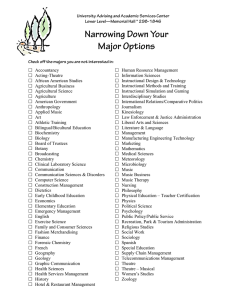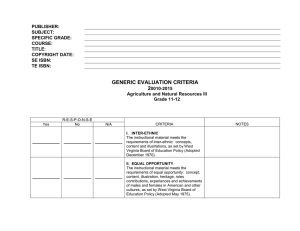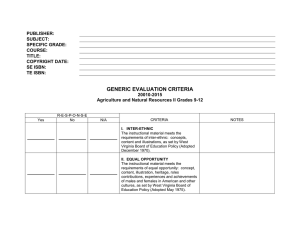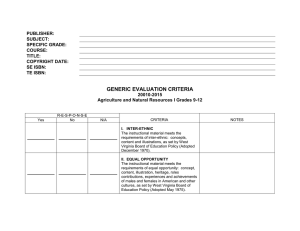GENERIC EVALUATION CRITERIA 2
advertisement
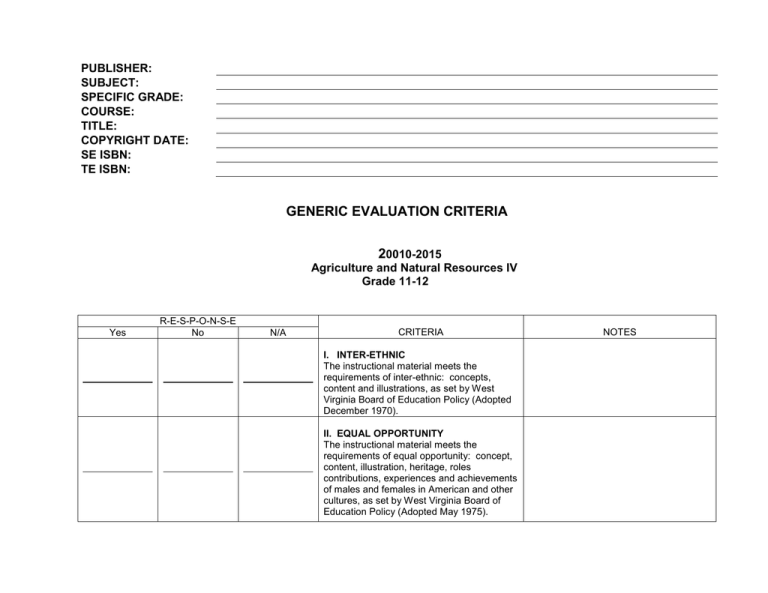
PUBLISHER: SUBJECT: SPECIFIC GRADE: COURSE: TITLE: COPYRIGHT DATE: SE ISBN: TE ISBN: GENERIC EVALUATION CRITERIA 20010-2015 Agriculture and Natural Resources IV Grade 11-12 Yes R-E-S-P-O-N-S-E No N/A CRITERIA I. INTER-ETHNIC The instructional material meets the requirements of inter-ethnic: concepts, content and illustrations, as set by West Virginia Board of Education Policy (Adopted December 1970). II. EQUAL OPPORTUNITY The instructional material meets the requirements of equal opportunity: concept, content, illustration, heritage, roles contributions, experiences and achievements of males and females in American and other cultures, as set by West Virginia Board of Education Policy (Adopted May 1975). NOTES INSTRUCTIONAL MATERIALS ADOPTION: 21st CENTURY LEARNING EVALUATION CRITERIA 20010-2015 Agriculture and Natural Resources IV Grade 11-12 (Vendor/Publisher) SPECIFIC LOCATION OF CONTENT WITHIN PRODUCT (IMR Committee) Responses I=In-depth A=Adequate M=Minimal N=Nonexistent I A M N In addition to alignment of Content Standards and Objectives (CSOs), materials must also clearly connect to Learning for the 21st Century which includes opportunities for students to develop A. Learning Skills Thinking and Problem-Solving Skills. Information and Communication Skills. Interpersonal and Self-Direction Skills and use these 21 Century Tools B. 21st Century Tools Problem-solving tools (such as spreadsheets, decision support, design tools) Communication, information processing and research tools (such as word processing, e-mail, groupware, presentation, Web development, Internet search tools) Personal development and productivity tools (such as e-learning, time management/calendar, collaboration tools) INSTRUCTIONAL MATERIALS ADOPTION: 21st Century Learning EVALUATION CRITERIA The general evaluation criteria apply to each grade level and are to be evaluated for each grade level unless otherwise specified. These criteria consist of information critical to the development of all grade levels. In reading the general evaluation criteria and subsequent specific grade level criteria, e.g. means “examples of” and i.e. means that “each of” those items must be addressed. Eighty percent of the combined general and specific criteria must be met with I (In-depth) or A (Adequate) in order to be recommended. 20010-2015 Agriculture and Natural Resources IV Grade 11-12 (Vendor/Publisher) SPECIFIC LOCATION OF CONTENT WITHIN PRODUCT (IMR Committee) Responses I=In-depth A=Adequate M=Minimal N=Nonexistent I A M For student mastery of content standards and objectives, the instructional materials will provide students with the opportunity to 4. Multimedia 1. offer appropriate multimedia (e.g., software, audio, visual, internet access) materials. 2. provide a website which provides links to relevant sites as well as lesson plans, student activities and parent resources. 3. integrate technology into the curriculum. N B. Scientifically-Based Research Strategies 1. provide explicit instructional strategies to present varied teaching models including but not limited to webbing, mapping, Venn diagrams and inverted pyramids. 2. promote writing skills and study techniques . 3. present varied teaching models with emphasis on differentiated instruction in content, process, and product. C. Critical Thinking 1. emphasize questioning models to promote higher order thinking skills based on Bloom’s Taxonomy. 2. promote student-generated responses. D. Life Skills 1. address life skills (e.g., health related concepts, goal setting, application to career oriented goals, reference tools, and researching). 2. address habits of mind activities (e.g., literacy skills, interpersonal communications, problem solving, and self-directional skills). E. Classroom Management 1. include opportunities for large group, small group, and independent learning. 2. provide classroom management suggestions. 3. provide suggestions for differentiated instruction (e.g., practice activities, learning stations, assessment, lesson plans). F. Instructional Materials 1. address varied learning styles and multiple intelligences of students by including models. 2. provide extensive and varied opportunities to practice skills. 3. provide intervention, practice, and enrichment materials. 4. continue skill or strategy instruction across several instructional sessions to expand the applicability and utility of the skill or strategy. 5. connect previously taught skills and strategies with new content and text. 6. cumulatively build a repertoire of multiple strategies that are introduced, applied, and integrated throughout the course of study. G. Assessment 1. provide opportunities for assessment based on performance-based measures, open-ended questioning, portfolio evaluation, rubrics, and multimedia simulations. 2. provide on-going progress monitoring. 3. provide rubric-based differentiated assessment. INSTRUCTIONAL MATERIALS ADOPTION: CONTENT SPECIFIC EVALUATION CRITERIA 20010-2015 Agriculture and Natural Resources IV Grade 11-12 The area of agriscience is designed to provide students with knowledge, skills, and competencies needed to enter various occupations in agriculture and natural resources. Topics covered in agriscience are animal science, plant science, agricultural mechanics, microcomputer applications, leadership, and Supervised Agricultural Experience programs. Safety instruction is integrated into all activities. Teachers should provide each student with real world learning opportunities and instruction related to selection, development, and maintenance of individual Supervised Agricultural Experience (SAE) programs. Students are encouraged to become active members of FFA, the national youth organization for those enrolled in agricultural education. FFA is an integral component of the program and provides curricular opportunities that enhance student achievement. Teachers should utilize relevant FFA activities to support experiential learning. The West Virginia Standards for 21st Century Learning include the following components: 21st Century Content Standards and 21st Century Learning Skills and Technology Tools. All West Virginia teachers are responsible for classroom instruction that integrates learning skills, technology tools, and content standards and objectives. Standard 1: Nature of Agriculture and Natural Resources Students will: demonstrate an understanding of the scope of the food and fiber industry. demonstrate the ability to use the inquiry process to solve problems. Standard 2: Content of Studies in Agriculture and Natural Resources IV Students will: demonstrate knowledge, understanding, and applications of facts, concepts, principles, theories, and models as delineated in the objectives. relate the principles contained in the sciences, economics, mathematics, and language arts to the agricultural industry Standard 3: Application of Knowledge and Skills Acquired Through Studies of Agriculture and Natural Resources IV Students will apply the principles of the sciences, economics, mathematics, and language arts to the agricultural industry. analyze information and situations to select the best means of performing tasks associated with agriscience demonstrate an ability to utilize technology to perform tasks associated with studies in agriculture and natural resources. evaluate agricultural commodities and processes and defend decisions related to such. engage in work-based learning through Supervised Agricultural Experience (SAE) programs. Standard 4: Participation in the student organization Students will participate in a local student organization. (Vendor/Publisher) SPECIFIC LOCATION OF CONTENT WITHIN PRODUCT (IMR Committee) Responses I=In-depth A=Adequate M=Minimal N=Nonexistent I A M For student mastery of content standards and objectives, the instructional materials will provide students with the opportunity to A. Nature of Agriculture and Natural Resources 1. develop leadership skills related to the agriculture industry. N 2. explore nutritional needs of humans and the processes used in food science to ensure an adequate food supply. 3. explore components, trends, and career opportunities in the food science industry. 4. determine the strategies and procedures for marketing agriculture commodities. 5. analyze various aquaculture, hydroponic, and greenhouse structures and management. 6. compare alternative energy sources in the agriculture industry. 7. develop and apply skills and concepts related to agricultural equipment, masonry, finishing, and MIG and Plasma Arc welding. 8. determine the scope and role of genetics and breeding in the agriculture industry. 9. examine aspects of biotechnology in agriscience. 10. assess methods of financial planning and management. 11. discuss personal traits necessary to secure and maintain employment. B. Content of Studies in Agriculture and Natural Resources IV 1. identify the characteristics of a good and poor leader. 2. assess the structural make-up of an organization. 3. differentiate methods of processing and preserving foods. 4. identify preconceptions of the food industry by producers and consumers. 5. examine characteristics of “value added” products and niche markets. 6. discuss food customs of major world populations and the impact on global and local demands. 7. analyze agricultural marketing approaches. 8. identify fees, commissions, taxes, regulations, etc. related to marketing agriculture commodities. 9. compare structures used in aquaculture, hydroponics, and greenhouse technology. 10. identify common aquaculture and hydroponics species; and types of plants propagated in greenhouses. 11. determine available alternative energy sources. 12. compare environmental and financial costs/benefits of traditional and alternative energy sources. 13. differentiate between the various types of agricultural harvesting equipment. 14. identify tools used in concrete and masonry. 15. explore preparation and pouring of concrete and mortar joints. 16. identify procedures for preparing metal and wood surfaces for finishing. 17. determine tools and supplies needed for surface finishing. 18. identify major parts and functions of MIG and plasma arc welding machines. 19. identify major parts and functions of MIG and plasma arc welding machines. 20. examine genetic principles (genes, chromosomes, gametes, DNA, RNA, etc.). 21. assess reproductive tracts for common agricultural animals. 22. compare and contrast breeding systems. 23. discuss methods of plant and animal improvement using biotechnology. 24. debate safety, ethical, social, economical, and scientific concerns of biotechnology. 25. assess financial concerns for personal and agricultural uses (taxes, insurance, credit, estate, loans, etc.). 26. identify work habits that are necessary for employment. 27. list components of applications, resumes, references, letters of applications, and interview structure. C. Application of Knowledge and Skills Acquired Through Studies of Agriculture and Natural Resources III 1. model leadership in committee activities. 2. conduct food processing and food preservation experiments. 3. interview someone employed in an agribusiness. 4. develop a marketing plan for an agriculture business. 5. research species grown in greenhouses, hydroponic systems, and aquaculture systems. 6. conduct experiments involving greenhouse, hydroponic, and aquaculture species. 7. debate the economic, environmental, and social significance of alternative energy sources. 8. calculate masonry volumes and courses. 9. participate in a masonry project. 10. apply surface finishes to wood and metal. 11. construct metal projects using MIG and Plasma Arc equipment safely. 12. select breeding methods for agriculture enterprises. 13. investigate market presence of biotech products. 14. conduct biotechnology experiments. 15. develop personal and work based experience budgets. 16. prepare a tax return. 17. prepare resume and letter of application. 18. conduct mock interviews. 19. compose SAE portfolios.
